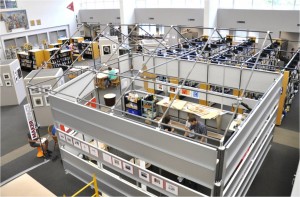Below is a dispatch from The Technologies of Makerspaces workshop, attended recently by Heather Stafford and Rebekah Irwin…
But wait! Before you read on, it might be helpful to browse the following Wikipedia entries: Maker culture, DIY culture, Hackerspaces, Fab Labs, Raspberry Pi, 3D Printing, and STEM fields (also sometimes STEAM[ref]Science, Technology, Math, “Art” and Math.[/ref] with an “A” for art).
So what’s a makerspace? Generally, a place where DIYers, Makers, and anyone else interesting in making things, designing things, or fixing things, rather than plain ol’ buying things, join together to fabricate, code, build, and collaborate. Makerspaces are also something of a theoretical ideal: a communal educational environment where kids and adults can use new, and old, hands-on tools in meaningful and creative ways.
Why were we at a Makerspace workshop? The article, What is a Makerspace? Creativity in the Library [ref]http://www.alatechsource.org/blog/2012/12/what-is-a-makerspace-creativity-in-the-library.html[/ref] helps answer that question:
When most people think of libraries, they naturally think books. Anyone working in a library today, however, knows that we are so much more than just books. Libraries are places of community engagement. Recently many libraries have begun to develop spaces for design and activities that both teach and empower patrons. The learning in these spaces varies wildly–from home bicycle repair, to using 3D printers, to building model airplanes. Fittingly, they are called makerspaces.
So we went to learn how a makerspace, and the culture of designing, creating, and building, might fit into the activities that are already taking place in our library spaces and across campus. We learned about 3D printing from colleges and universities already doing it (like Williams, Yale, Colgate, Brandeis and Wheaton); we watched the blinking lights on our instructor’s handknit scarf thanks to an Arduino LilyPad microcontroller board and conductive sewing thread; and to top off our day, we hooked up peripherals and booted up the Raspbian operating system on a Raspberry Pi Model B.
Presentation materials were shared with all attendees and included this slideshare on the Technologies of Makerspaces as well as a Google presentation on 3D printing.
Thanks for reading.

so, did middlebury go on to have a makerspace? I’m at Kenyon College and we are thinking about it.